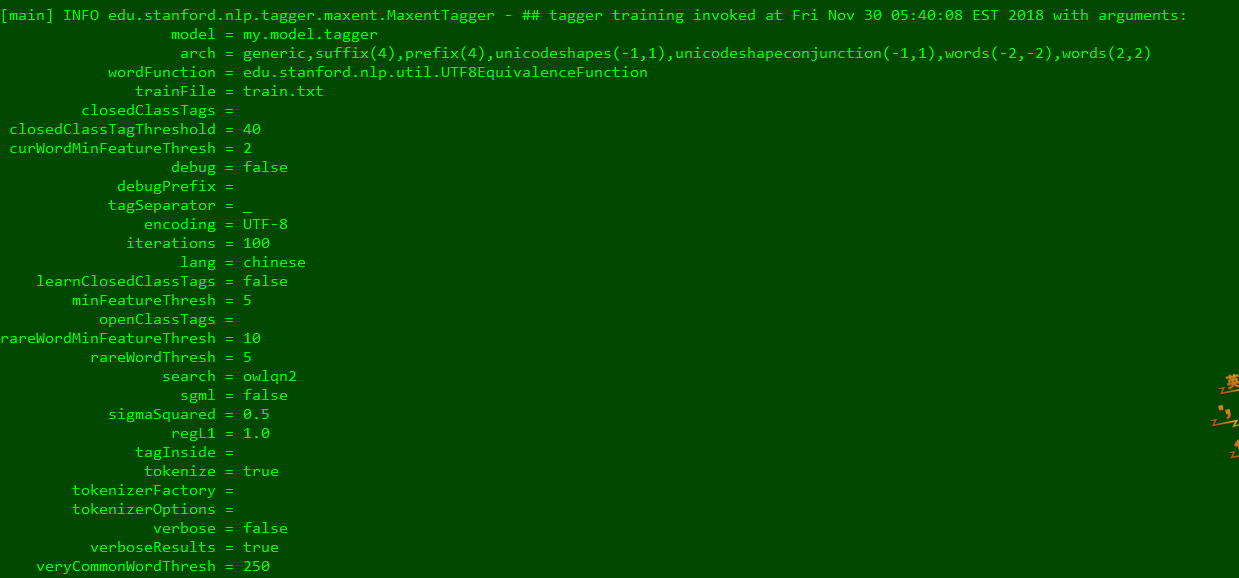

Where we are trying to model sequential data like text or sound and learn to model it. More specifically the issue we are trying to solve known as sequence modeling. Deep learning Approach Sequence modeling and RNNs So what we are trying to accomplish here is to overcome this issue and find an approach that doesn’t ignore the context of the data. Ignoring the context when tagging words will only result in the baseline of acceptance as the approach would tagging each word with the most common tag associated with this word from the training set.
#Pos tagger stanford series#
This post is part of a series in building a python package for Arabic natural language processing. LSTM) and How it’s used in natural language processing in solving the sequence modeling task while building an Arabic part-of-speech tagger based on Universal Dependancy Tree Bank. The module uses the conditional random fields implementation provided by CRFsuite () and is trained on small manually annotated corpora.In this post, I will explain Long short-term memory network (aka. VUA Opinion Miner: a tool that detects opinions in English and Dutch text and for each opinion extracts:.NewsReader Factuality classifier: a tool that determines the factuality of expressions: a Mallet (McCallum 2002) classifier trained on FactBank v1.0 (Saurí and Pustejovsky, 2009).The classification is based on KYOTO-DOLCE. KYOTO event classifier: a tool that identifies whether events are a communication, cognition, or other.

CorefGraph:: a python reimplementation of the coreference resolution tool proposedīy the Stanford NLP group (Lee et al., 2013) for English and Spanish.It is a collection of programs that uses the Personal PageRank on the Lexical Knowledge Base (LKB) to rank vertices on the LKB. UKB based Word Sense Disambiguation: a tool that applies graph-based word sense disambiguation.This tool depends on the DBpedia Spotlight. Ixa-pipe-ned: A client to query the DBpedia Spotlight for Named Entity Disambiguation (Mendes et al., 2011). (Collins 2002) as implemented by Apache OpenNLP on CoNLL datasets for NER. ixa-pipe-nerc: English/Spanish Named Entity Recognition with Perceptron models.It is trained on TempEval3 data (UzZaman et al., 2013). TimePro: a tool identifying English temporal expressions.MATE-based SRL: a tool providing lemmatization, POS-tagging, dependencies and semantic roles for English and Spanish based on the MATE-tools (Björkelund et al., 2010).Alpino Parser: A version of the Alpino parser that uses NAF as input and output.MATE-based Parser: a tool providing lemmatization, POS-tagging, dependencies and semantic roles for English and Spanish based on the MATE-tools (Björkelund et al., 2010).

Stanford-based Parser: A probabilistic lexicalized dependency parser based on the Stanford statistical parser (Manning and Klein, 2003).ixa-pipe-parse: English/Spanish Constituent Parsing with Maximum Entropy models (Ratnaparkhi 1999) as implemented by Apache OpenNLP using the Penn and Ancora Treebanks respectively.Stanford-based POS-tagger: POS-tagging for English based on the Java implementation of the Stanford POS-tagger (Toutanova et al.ixa-pipe-pos:English/Spanish POS tagging with Perceptron models (Collins 2002) as implemented by Apache OpenNLP using the WSJ and Ancora corpus respectively.Stanford-based tokenizer: Sentence segmentation and tokenization for English as provided by Stanford CoreNLP.ixa-pipe-tok:A multilingual rule-based tokenizer for English and Spanish compliant with Penn Treebank and Ancora Corpus tokenization.NLP Modules that work with NAF Tokenization A generic news website parser (under development):.Pynaf: Yet another python library for NAF


 0 kommentar(er)
0 kommentar(er)
